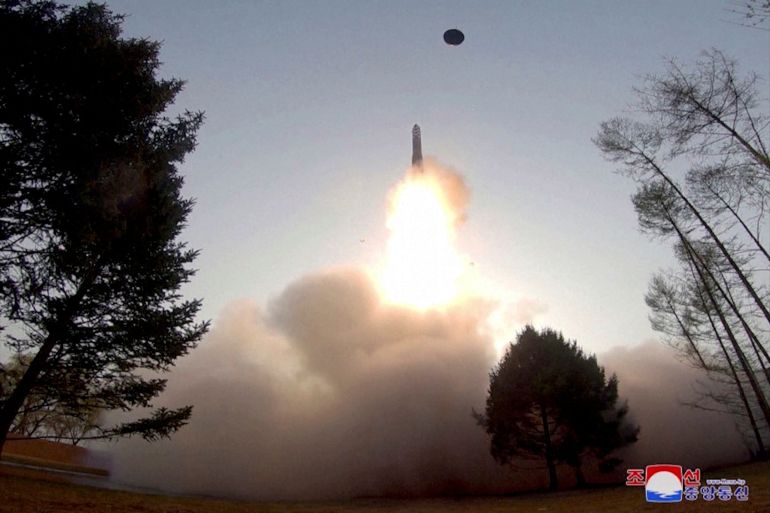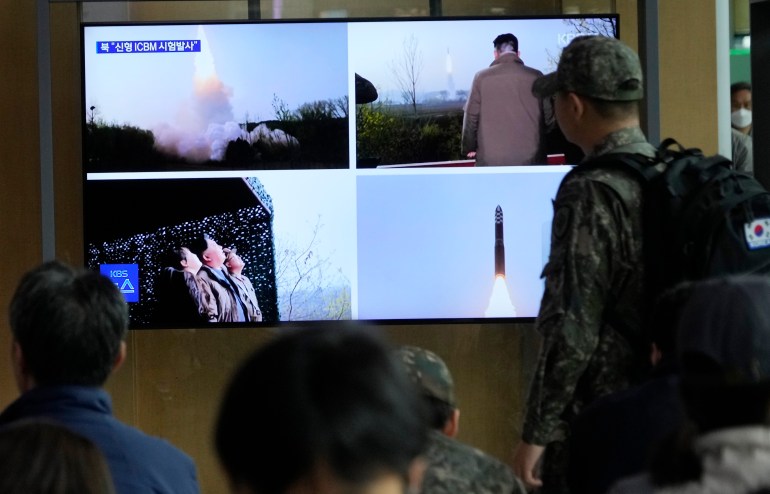What’s solid-fuel technology and why’s North Korea developing it?
A look at the characteristics of solid-fuel technology and how it can help North Korea improve its missile systems.

North Korea says it has successfully tested a new solid-fuel intercontinental ballistic missile (ICBM), its first known use of the propellant in a longer-range projectile.
But what exactly is a solid-fuel missile and why does it matter to have one?
Keep reading
list of 3 itemsNorth Korea tests first ever solid fuel ICBM, Hwasong-18
North Korea tests ‘breakthrough’ solid-fuel ICBM
What is solid-fuel technology?
Solid propellants are a mixture of fuel and oxidiser. Metallic powders such as aluminium often serve as the fuel, and ammonium perchlorate, which is the salt of perchloric acid and ammonia, is the most common oxidiser.
The fuel and oxidiser are bound together by a hard rubbery material and packed into a metal casing.
When solid propellant burns, oxygen from the ammonium perchlorate combines with aluminium to generate enormous amounts of energy and temperatures of more than 5,000 degrees Fahrenheit (2,760 degrees Celsius), creating thrust and lifting the missile from the launch pad.
What is the advantage of this technology?
Solid fuel is dense and burns quite quickly, generating thrust over a short time. Separately, it can remain in storage for an extended period without degrading or breaking down – a common issue with liquid fuel.
Vann Van Diepen, a former US government weapons expert who now works with the Washington-based North Korea monitoring project, 38 North, said solid-fuel missiles are easier and safer to operate. They also require less logistical support, making them harder to detect and more survivable than liquid-fuel weapons.
According to Joseph Dempsey, a research associate at the International Institute for Strategic Studies, one of the key advantages is that solid-fuelled missiles can be “fuelled from the point of manufacture”.
“They, therefore, allow operators to maintain a high state of readiness and the potential to launch within minutes, depending on basing,” Dempsey wrote in an analysis earlier this year.
In contrast, a liquid-fuelled ICBM would need to undergo a fuelling process before launch, said Dempsey. That could take hours, giving an adversary time to identify, react and neutralise it before its launch.
Who has this technology?
Solid fuel dates back to fireworks developed by the Chinese centuries ago, but made dramatic progress in the mid-20th century when the United States developed more powerful propellants.
The Soviet Union fielded its first solid-fuel ICBM, the RT-2, in the early 1970s, followed by France’s development of its S3, also known as SSBS, a medium-range ballistic missile.
China started testing solid-fuel ICBMs in the late 1990s.
South Korea said on Friday it had already secured “efficient and advanced” solid-propellant ballistic missile technology.
Why is North Korea investing in solid-fuel ICBM?
North Korea said the development of its new solid-fuel ICBM, the Hwasong-18, would “radically promote” its nuclear counterattack capability.
The official Korean Central News Agency cited leader Kim Jong Un as saying the Hwasong-18 would further support an aggressive military strategy that promises to maintain “nuke for nuke and an all-out confrontation for an all-out confrontation” against North Korea’s rivals.

What is next?
South Korea’s defence ministry sought to downplay the testing, saying the North would need “extra time and effort” to master the technology.
Ankit Panda, a senior fellow at the US-based Carnegie Endowment for International Peace, said the North could face difficulties ensuring such a large missile does not break apart when the diameter of the booster becomes larger.
Although the Hwasong-18 might not be a “game changer”, he said, it will most likely complicate the calculations of the United States and its allies during a conflict.
“The most important interest the United States and its allies have is to reduce the risks of nuclear use and escalation stemming from North Korea’s possession of these weapons,” Panda said.
Following North Korea’s launch on Friday, South Korea and the US conducted a joint air exercise involving a US B-52 bomber.
